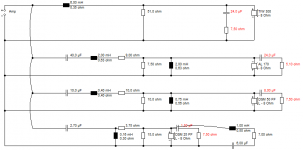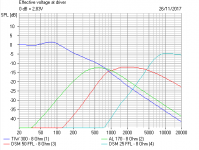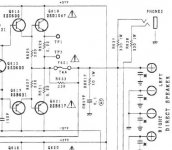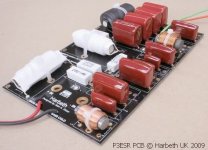Hi Friends,
I wanted to share with you something I found. It's the schematic of the aesthetically pleasing, but not terribly well received JBL 250 Ti:
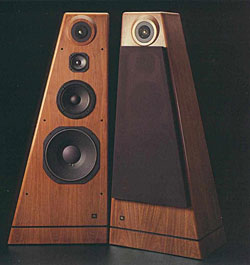
What I wanted to point out to you in particular is the extreme use of bypass caps in the crossover design. We may laugh at this now, but as the title of the thread says, this was considered the very height of audio design fussiness. Notice the repeated use of 0.01 uF AND 0.0055 uF to bypass most caps. The idea was that the smaller uF, the less likely it was to be inductive, and that you could build a nearly perfect cap this way.
Notice the repeated use of 0.01 uF AND 0.0055 uF to bypass most caps. The idea was that the smaller uF, the less likely it was to be inductive, and that you could build a nearly perfect cap this way.
At the very least, in line level audio circuits, the use of multiple voltage regulators, along with local PS bypass caps like electrolytic were usually bypassed by a tantalum cap to balance cost and performance.
Hope you find it as interesting as I did.

I wanted to share with you something I found. It's the schematic of the aesthetically pleasing, but not terribly well received JBL 250 Ti:

What I wanted to point out to you in particular is the extreme use of bypass caps in the crossover design. We may laugh at this now, but as the title of the thread says, this was considered the very height of audio design fussiness.
At the very least, in line level audio circuits, the use of multiple voltage regulators, along with local PS bypass caps like electrolytic were usually bypassed by a tantalum cap to balance cost and performance.
Hope you find it as interesting as I did.

Last edited:
JBL originally used 0.068uF polypropylene bypass caps on NPE & MKT caps; they later shifted mostly to MKT for main values, and stuck with them for years, with a 0.01uF MKP and 0.005uF polystyrene. The subjective reporting was that the MKP bypass helped with transients, the latter ambience. The general consensus was that using MKTs with bypasses sounded better, particularly for models with their compression units, than using MKPs for the main value & having done with it. Their top systems have since moved to DC biased MKPs -I don't think they include bypasses now.
YMMV. I've not experienced any significant value in small bypass caps, but JBL & Greg Timbers knew their drivers & what they were doing, while plenty of people have built bypassed JBL networks as upgrades to their originals, so I'll take their word for it for these particular speakers. It's not like it costs a lot either, as the caps are not exotic (JBL have precious little time for that kind of nonsense).
YMMV. I've not experienced any significant value in small bypass caps, but JBL & Greg Timbers knew their drivers & what they were doing, while plenty of people have built bypassed JBL networks as upgrades to their originals, so I'll take their word for it for these particular speakers. It's not like it costs a lot either, as the caps are not exotic (JBL have precious little time for that kind of nonsense).
For THIS, they make a living? 
I simplified it to default settings and took out the bypass caps. Not much to it, really!
I marked impedance correction in red. The little LCR network on the supertweeter is a shallow 2kHz notch. I am guessing the mid marked MF is a 4 ohm unit. I think I got polarity wrong on the supertweeter, but you get the point, I think. Thanks for that, Erik.
I can only make a case for a bypass cap on the tweeter section really, if Radio Frequency interference was a worry.
I simplified it to default settings and took out the bypass caps. Not much to it, really!
I marked impedance correction in red. The little LCR network on the supertweeter is a shallow 2kHz notch. I am guessing the mid marked MF is a 4 ohm unit. I think I got polarity wrong on the supertweeter, but you get the point, I think. Thanks for that, Erik.
I can only make a case for a bypass cap on the tweeter section really, if Radio Frequency interference was a worry.
Attachments
It doesn't matter what case you make for it Steve. JBL and their enthusiasts don't give a hoot what you think about it, and if you wish to go over to where they hang out, you'll discover that for yourself. They've heard it all before, many, many times and have a short response to those who think they know better than they do what their own results are.
You may wish to recall that the 250 dates to the early-mid 1980s. Adjustable L-pads were part of the network design, as was extensively employed in their studio monitors, while some of the larger capacitor values by necessity were created from several parallel units as larger MKT film caps were not available at sufficient tolerance. Hence the number of components and apparent complexity of the circuit diagram. As for the small bypass caps, JBL were happy with the acoustic results of adding them to their contemporary MKTs, the owners were happy, and a large number of people who used unbypassed JBL networks subsequently built bypassed variations (either to JBLs spec. where available, or modified the existing filters) and felt they provided a small improvement.
You may wish to recall that the 250 dates to the early-mid 1980s. Adjustable L-pads were part of the network design, as was extensively employed in their studio monitors, while some of the larger capacitor values by necessity were created from several parallel units as larger MKT film caps were not available at sufficient tolerance. Hence the number of components and apparent complexity of the circuit diagram. As for the small bypass caps, JBL were happy with the acoustic results of adding them to their contemporary MKTs, the owners were happy, and a large number of people who used unbypassed JBL networks subsequently built bypassed variations (either to JBLs spec. where available, or modified the existing filters) and felt they provided a small improvement.
Last edited:
I happen to know quite a lot about Radio Frequency engineering. It was my first job, working on 45MHz systems where 10pF of stray capacitance was a lot! 
And in RF, you often do bypass capacitors to reduce parasitic inductance. Tanatalum bead, Mica, you name it. Even adds that fascinating power supply trouble to PC video cards known as capacitor squeal and coil whine, which is a high pitched audible noise that can be annoying to the gamers.
Happily most audio amps have a 10R/0.1uF metal oxide/MKT Zobel at the output to keep stable around 100kHz with varied load conditions, even no load at all. Because it is quite possible for a speaker cable to behave like an antenna.
So what might be the effect of a parallel 0.01uF MKP on 40uF of MKT? Not much below a MHz, IMO. TBH, snake oil might be cheaper.
Interestingly, Harbeth use pure MKT and even ferrite coils on tweeter circuits. Must sound rubbish!
And in RF, you often do bypass capacitors to reduce parasitic inductance. Tanatalum bead, Mica, you name it. Even adds that fascinating power supply trouble to PC video cards known as capacitor squeal and coil whine, which is a high pitched audible noise that can be annoying to the gamers.
Happily most audio amps have a 10R/0.1uF metal oxide/MKT Zobel at the output to keep stable around 100kHz with varied load conditions, even no load at all. Because it is quite possible for a speaker cable to behave like an antenna.
These are also the first speakers from JBL whose large crossover capacitors are bypassed by small ones, reducing the effects of dielectric absorption. This is strict perfectionism, but JBL ascertained to their own satisfaction that bypassing did, in fact, improve the sound.
Read more at JBL 250Ti loudspeaker | Stereophile.com
So what might be the effect of a parallel 0.01uF MKP on 40uF of MKT? Not much below a MHz, IMO. TBH, snake oil might be cheaper.
Interestingly, Harbeth use pure MKT and even ferrite coils on tweeter circuits. Must sound rubbish!
Attachments
Last edited:
I happen to know quite a lot about Radio Frequency engineering...
Variations of which point you frequently remind everybody of.
Happily most audio amps have a 10R/0.1uF metal oxide/MKT Zobel at the output to keep stable around 100kHz with varied load conditions, even no load at all. Because it is quite possible for a speaker cable to behave like an antenna.
Quite, but we're not talking about amplifiers.
So what might be the effect of a parallel 0.01uF MKP on 40uF of MKT? Not much below a MHz, IMO. TBH, snake oil might be cheaper.
If you'd bothered to read what I'd written, you might have noticed the following comment:
I've not experienced any significant value in small bypass caps, but JBL & Greg Timbers knew their drivers & what they were doing, while plenty of people have built bypassed JBL networks as upgrades to their originals, so I'll take their word for it for these particular speakers.
What do they do? Nothing as regards the corner frequency for blatantly obvious reasons, nor are there many technical arguments that are especially convincing either. The contemporary view, which still seems to be favoured amongst JBL users, was that they subjectively appeared to restore the leading edge on transients. Quantifiable? No. Cheap (about a quid) for people to try however, and the heritage JBL users who are not lacking for experience with their own setups are happy enough with it as an inexpensive upgrade, and in some cases prefer it (especially on setups with compression horns) to substituting a stock full-value MKP or even DC biased MKPs. As noted, I'm neutral on the subject as far as JBL goes; they are something of an exceptional case, particularly when you get to their big HE systems. In other circumstances / for other setups, I certainly wouldn't bother.
Interestingly, Harbeth use pure MKT and even ferrite coils on tweeter circuits. Must sound rubbish!
Which they don't, as most people acknowledge. They make some of my favourite reasonably sized commercial speakers. That does not mean however that Alan's design choices must be blindly followed in every circumstance.
Last edited:
TBH, Scott, I don't think we need worry about RF frequencies in audio. Amplifier designers, of which I used to be one, take care of the instability horrors which lie above 20 kHz with feedback designs. Some standard techniques. 
If our amps blow up, even if it's not strictly my fault, it's gonna cost our company a lot of money and embarrassment to fix, and for me a loss of Kudos in the workplace.
But really, why should I have to apologise for being moderately competent with this audio business. If you have cancer, are you going to consult a hungover bricklayer or an experienced cancer surgeon for the best outcome?
It's a question of believability. I make no claim to having the insight of Albert Einstein. His ability to see the stuff that matters, and the stuff that doesn't. An ability to see the simple pattern, despite everybody else in his class knowing more mathematically about 4D geometry.
As it goes, I enjoyed this thread about the JBL 250Ti. Ti for titanium dome tweeter. I have modelled it a bit, and can see some strengths there. JBL make good drivers. Low mechanical loss an' all that. Low order filters and a flat "Monitor" frequency response might be more debateable. I think the review talked about the restrained (Boston) East Coast versus the flat West Coast sound.
I actually can think of about 5 factors that make for a goodish speaker working in a real room. Most folks only think about on-axis frequency response.
If our amps blow up, even if it's not strictly my fault, it's gonna cost our company a lot of money and embarrassment to fix, and for me a loss of Kudos in the workplace.
But really, why should I have to apologise for being moderately competent with this audio business. If you have cancer, are you going to consult a hungover bricklayer or an experienced cancer surgeon for the best outcome?
It's a question of believability. I make no claim to having the insight of Albert Einstein. His ability to see the stuff that matters, and the stuff that doesn't. An ability to see the simple pattern, despite everybody else in his class knowing more mathematically about 4D geometry.
As it goes, I enjoyed this thread about the JBL 250Ti. Ti for titanium dome tweeter. I have modelled it a bit, and can see some strengths there. JBL make good drivers. Low mechanical loss an' all that. Low order filters and a flat "Monitor" frequency response might be more debateable. I think the review talked about the restrained (Boston) East Coast versus the flat West Coast sound.
I actually can think of about 5 factors that make for a goodish speaker working in a real room. Most folks only think about on-axis frequency response.
Scott Speaketh Thus:
True. That part is normal. I just wanted to point out the RF bypassing caps added onto that. I was almost 3 decades away from being able to buy my own DATS V2 so I could tell if any of that made the difference they expected it to. I do remember sometime around here is when MultiCap made a name for themselves, and the exotic windings (AFAIK) all date from around the same time frame.
I make no claims here as to audibility in this design!
Best,
E
while some of the larger capacitor values by necessity were created from several parallel units as larger MKT film caps were not available at sufficient tolerance. Hence the number of components and apparent complexity of the circuit diagram
True. That part is normal. I just wanted to point out the RF bypassing caps added onto that. I was almost 3 decades away from being able to buy my own DATS V2 so I could tell if any of that made the difference they expected it to. I do remember sometime around here is when MultiCap made a name for themselves, and the exotic windings (AFAIK) all date from around the same time frame.
I make no claims here as to audibility in this design!
Best,
E
I have this loudspeaker, and i must confess this is one of best speaker i ever has listen to
the only one i can say that is on same level is B&W 800 d3, but the price is another world !
but its hard to compare speakers i think, because it depent on many things(what amplifier and the room)
have also listen to this jbl250ti with a too small amplifier, and that sounds bad !
the only one i can say that is on same level is B&W 800 d3, but the price is another world !
but its hard to compare speakers i think, because it depent on many things(what amplifier and the room)
have also listen to this jbl250ti with a too small amplifier, and that sounds bad !
Not sure what OP is "laughing" about. A crossover isn't something the marketing department boasts about. Those complex XOs (pioneered by the good old BBC box) were created to produce flat on-axis sound and on a good day, total power too. - not great electric curves which are of secondary relevance. And in this case, also to provide essential user adjustment. ( Although designed prior to his engagement at Harmon, Toole touts "tone controls" in two dozen places in the 3rd edition.)
With REW (and esp with DSP too), you can make this speaker produce the house curve you want. That's nothing to laugh about.
With REW (and esp with DSP too), you can make this speaker produce the house curve you want. That's nothing to laugh about.
Last edited:
- Status
- This old topic is closed. If you want to reopen this topic, contact a moderator using the "Report Post" button.
- Home
- Loudspeakers
- Multi-Way
- JBL 250 Ti - SOTA Xovers in 1983-ish
